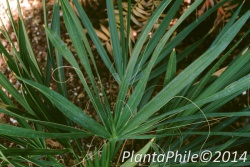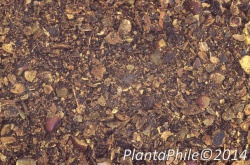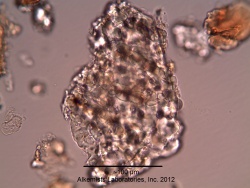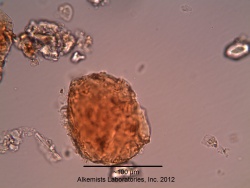Serenoa repens (fruit)
Contents |
Nomenclature
Serenoa repens (W. Bartram) Small Arecaceae
Syn. Sabal serrulata (Michx.) Nutt. ex Schult. & Schult. f.; Serenoa serrulata (Michx.) G. Nichols.
Standardized common name (English): saw palmetto
Botanical Voucher Specimen
Organoleptic Characteristics
|
Macroscopic Characteristics
|
Microscopic Characteristics
|
DNA Identification
|
Saw Palmetto (Serenoa repens) Amplification primers: matK mini–barcode forward (5′-TCT AAA GCT AAA TTT TGT ACC GTA TCG-3′) and reverse (5′-GCC AAA GTT CTA GCA CAC GAA-3′) rbcL mini–barcode forward (5′-GCT ATC ACA TCG AAA CCG TTG-3′) and reverse (5′-GCC TTG GAA AGT TTT GGA ATA AG-3′) PCR reaction mixture: matK mini–barcode: 15 µL final volume containing 1.5 µL PCR buffer (200 mM tris [pH 8.8], 100 mM KCl, 100 mM (NH4)2SO4, 20 mM MgSO4, 1% [v/v] Triton X-100, 50% [w/v] sucrose, 0.25% [w/v] cresol red), 0.2 µM dNTPs, 0.025 μg/μL bovine serum albumin (BSA), 1 μM of each primer, 0.25 units of Taq polymerase, and 0.5 µL template DNA. rbcL mini–barcode: 15 µL final volume containing 1.5 µL PCR buffer (200 mM tris [pH 8.8], 100 mM KCl, 100 mM (NH4)2SO4, 20 mM MgSO4, 1% [v/v] Triton X-100, 50% [w/v] sucrose, 0.25% [w/v] cresol red), 0.2 µM dNTPs, 0.025 μg/μL bovine serum albumin (BSA), 48 mM betaine, 1 μM of each primer, 0.25 units of Taq polymerase, and 0.5 µL template DNA. PCR program: 95°C for 2.5 min; 35 cycles: 95°C for 30 s, 60°C for 30 s; 60°C for 10 min. Sequencing primers: Same as amplification primers. Sequence: matK mini–barcode: 5′-GGG CAT CCT ATT AGT AAG CCG ATC TGG ACC GAT TTA TCA GAT TGC GAT ATT ATT GAT CGA TTT GGT CGG ATA TGT AGA AAT CTT TCT CAT TAT CAC AGT GGA TCC TCA AAA AAA CAG AGT TTG TAT CGA ATA AAG TAT ATA CTT CGG TT-3′ rbcL mini–barcode: 5′-TCG GGG AGG AAA ATC AAT ATA TTG CTT ATG TAG CTT ATC CTT TAG ACC TTT TTG AAG AAG GTT CTG TTA CTA ACA TGT TTA CTT CCA TTG TGG GTA ATG TAT TTG GTT TCA AAG CCC TAC GAG CTC TAC GTC TGG AGG ATC TGC GAA TTC CCA CTT-3′ Diagnostic positions: matK mini–barcode
66667777777778888
78893455668890111
85958437565682678
Brahea YGGCCTCCCAACCTCGA
Rhapidinae Chamaerops C..Y..YY....Y....
Rhapidinae Guihaia C................
Rhapidinae Maxburretia C................
Rhapidinae Rhapidophyllum C................
Rhapidinae Rhapis C................
Rhapidinae Trachycarpus C................
Livistoninae Johannesteijsmannia C....W...RR......
Livistoninae Lanonia CR...............
Livistoninae Licuala CR..Y...Y.....M..
Livistoninae Livistona C................
Livistoninae Pholidocarpus C..........Y.A..R
Livistoninae Pritchardiopsis C..............T.
Livistoninae Saribus CRK............K.
Acoelorrhaphe wrightii C...............G
Serenoa repens C...............G
rbcL mini–barcode
222233
558909
130218
Brahea GGTCAA
Rhapidinae Chamaerops ......
Rhapidinae Guihaia ......
Rhapidinae Maxburretia ......
Rhapidinae Rhapidophyllum ......
Rhapidinae Rhapis ..C...
Rhapidinae Trachycarpus ......
Livistoninae Johannesteijsmannia .....C
Livistoninae Lanonia ??????
Livistoninae Licuala RR...M
Livistoninae Livistona .....M
Livistoninae Pholidocarpus ....GC
Livistoninae Pritchardiopsis .....C
Livistoninae Saribus .....C
Acoelorrhaphe wrightii ...T.C
Serenoa repens ......
|
Supplementary Information
Sources
- ↑ United States Dispensatory (1918)
- ↑ American Medicinal Plants of Commercial Importance (1930)
- ↑ United States Dispensatory (1918)
- ↑ PlantaPhile http://plantaphile.com/
- ↑ PlantaPhile http://plantaphile.com/
- ↑ United States Dispensatory (1918)
- ↑ Elan M. Sudberg, Alkemist Laboratories http://www.alkemist.com
- ↑ Elan M. Sudberg, Alkemist Laboratories http://www.alkemist.com
- ↑ Elan M. Sudberg, Alkemist Laboratories http://www.alkemist.com






